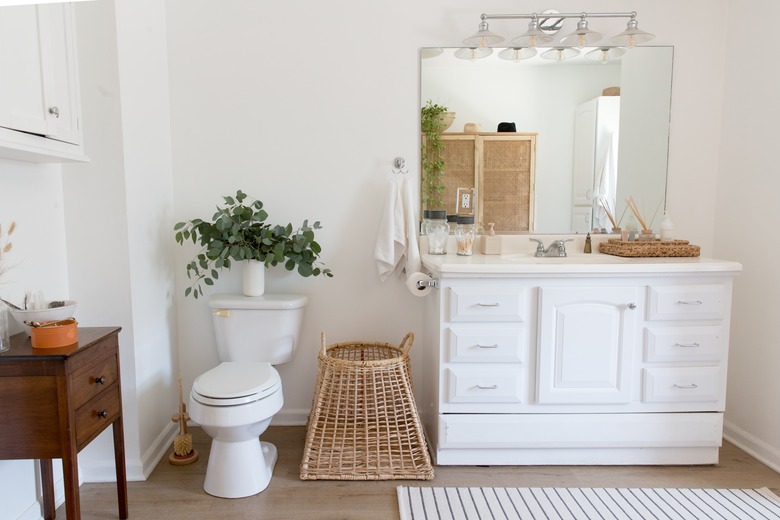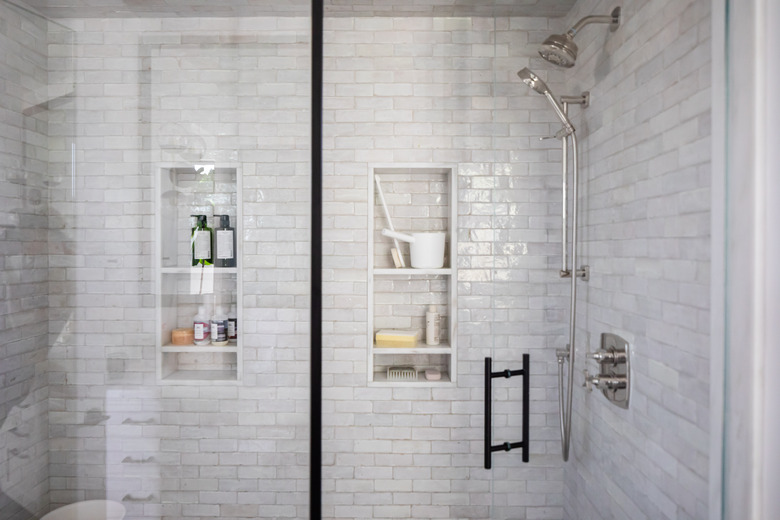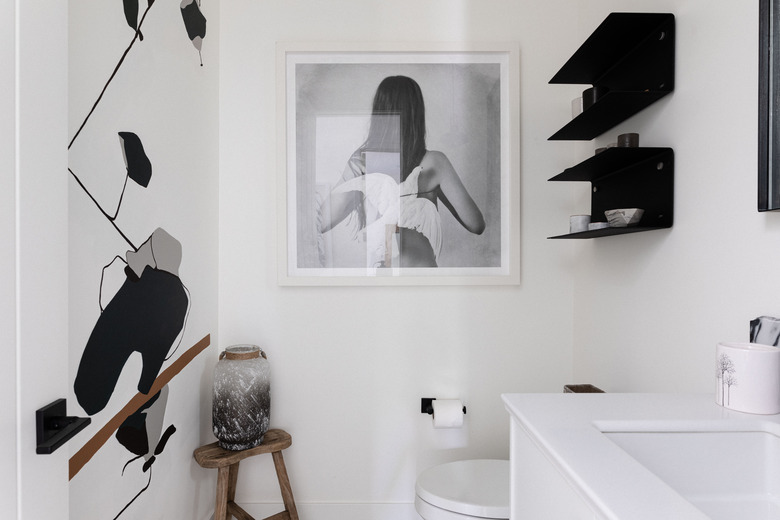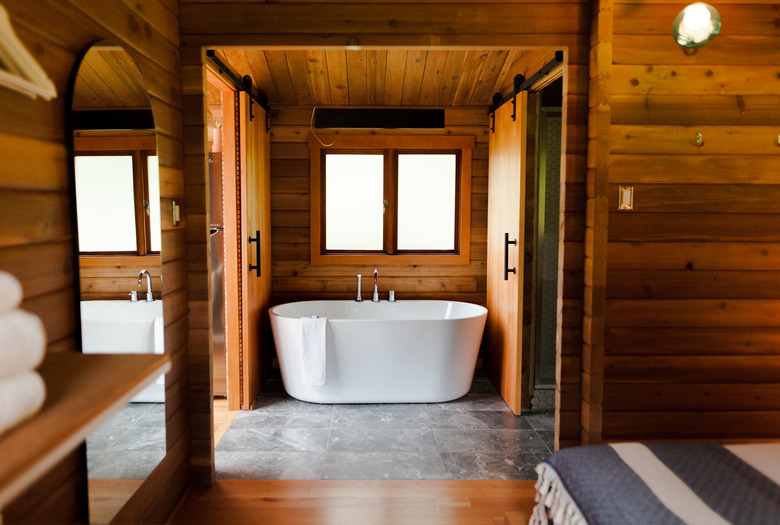Reducing Costs Of A Major Bathroom Remodel
- Average bathroom renovation cost
- How bathroom renovation differs from makeovers
- Hiring a professional
- Incorporate savings in your bathroom design
- Think conservatively about the shower
- Look for a new toilet that performs well
- Bathroom remodel cost: high cost doesn't mean high quality
- Buy the right materials
Many of us dream about remodeling our bathroom, but we worry that the typical bathroom renovation cost is too high for our home improvement budget. However, you don't need to spend a fortune to have a nice bathroom. Even if you need to do a major renovation, there are still ways to save money as long as you don't go overboard on expensive extras like designer fixtures, a luxury walk-in shower or a high-tech toilet with a heated seat.
Average Bathroom Renovation Cost
The estimates for a major bathroom remodel can be all over the place depending on where you look, but if you learn where these sources come up with their numbers, you can get a better idea of how much you can expect your bathroom renovation to cost.
HomeAdvisor's cost guide is based on project costs reported from the site's users. A survey of over 18,000 users has found that the national average for bathroom remodels is around $10,462, with DIY and minor or low-end remodels costing as little as $2,500 and high-end remodels coming in at upward of $25,000. They even point out that a luxury remodel in a large master bathroom can easily cost more than $50,000.
If you're expecting to do a full tearout of everything from the toilet to the drywall, you can expect to spend between $6,000 and $15,000, though obviously these prices will vary largely based on the size of your bathroom.
The estimates featured at Remodeling are a bit higher than most other sources, but these numbers are particularly useful because they provide an average bathroom renovation cost based on a specific set of plans. For example, the average cost for a midrange, 35-square-foot bathroom redesign is $21,377.
This remodel requires installing a 30 x 60-inch tub/shower combo, a new toilet, a solid-surface vanity counter, a recessed medicine cabinet, a tile floor and wall tiling around the shower area. A nice feature of Remodeling's estimates is that it also provides the resale value you can expect to recoup after renovating. In the case of a midrange bathroom remodel, a homeowner should expect to recoup 64 percent, or $13,688 of what was spent.
For those looking to create a truly luxurious bathroom, Remodeling estimates that the cost of turning a 35-square-foot bathroom into an elegant 100-square-foot space will cost $67,106. This estimate covers relocating all fixtures, adding a bathtub with high-end faucets and a separate, glass-enclosed shower, a double vanity with stone counters, a compartmentalized area for the toilet and tile flooring over heated floors.
It's worth noting that these expensive bathroom remodeling costs may be worth it for those who genuinely want to enjoy their new bathroom design, but if you're looking to increase your home value prior to selling, this isn't a great investment since it will only allow you to recoup 56.6 percent of your money — around 8 percent less than you could get back with the midrange renovation.
How Bathroom Renovation Differs From Makeovers
A home remodeling project can take on different meanings for different people, but when you're talking about a major bathroom remodel, you're looking at a full bathroom demolition and not just some minor changes. A bathroom makeover might involve a minor project like switching out a vanity, replacing a toilet or changing the flooring. On the other hand, a full renovation will frequently involve hiring a general contractor, obtaining building permits, a total demolition of everything inside the room and maybe even modifying the floor plan to expand the total square footage of the bathroom.
Hiring a Professional
Labor costs can make up anywhere from 40 to 60 percent of your total budget, so you'll want to spend a lot of time making sure you find the right professionals to complete your remodel. While many people opt for the cheapest experts they can find, remember that between the plumbing work and the small work area, a lot can go wrong in a bathroom remodel, and you want to ensure that your contractor will be the type to fix problems quickly as they arrive — not be the one to cause the problem.
You can ask friends, family members or professional associations such as the National Kitchen & Bath Association for referrals, but also check a contractor's reviews online, review his standing with the BBB and make sure he is licensed and insured. Always get quotes from at least three contractors who have high reviews. Don't just consider price but also make sure you get along with him since you'll likely spend a lot of time in close proximity with your bathroom remodeler.
If you're working with a general contractor, ask for a list of any subcontractors he will hire (this may include an electrician, a tile layer, a plumber, a cabinet installer and more) and then be sure to check those contractors' reviews and standing with the BBB as well.
Before getting started, be sure to ask if there are any local building code ordinances that may affect your design and find out if you will need any permits. If the contractor says you will need permits, ask if you should obtain them or if he will and then ask who will cover the permit costs so you can account for these in your budget if they're not included in the contractor's fees.
Even if you're working with the top contractor in the world, you'll also want to make sure to set aside anywhere from 10 to 15 percent of your total budget as a cushion in case problems arise. It's not uncommon for someone to start work on a bathroom renovation only to discover the bathroom has existing water damage or a mold problem, and you need to have money readily available to handle these types of problems.
Incorporate Savings in Your Bathroom Design
You may ideally want a whole new layout in your bathroom, but it's best to leave the sink, toilet and shower lines all where they are when possible. Before scraping your existing floor plan, consider the fact that Consumer Reports points out that moving your toilet only 1 foot over can easily cost $1,000 since the plumber may have to remove both the subfloor and walls to access the pipes. If you just need a few extra inches to squeeze in a bigger vanity, you might instead invest in a $10 offset flange to allow the toilet to move slightly to the side.
While many people like to have the toilet hidden away from the rest of the room, keep in mind that this doesn't always mean installing a new wall. This can often be accomplished just as well with a piece of furniture like an armoire or bookshelf unit that will not only save money but also add additional storage space in the room.
If your bathtub coating is cracked or you hate the color, you may be able to just reglaze it for a few hundred dollars, whereas a new tub can cost up to $1,000 plus installation costs. While you might have a small bathroom that can't fit a separate tub and shower, don't always jump on the walk-in shower trend without leaving at least one bathtub in the house, as this can lower your resale value.
Think Conservatively About the Shower
Yes, most of us would love a massive new shower with a rainfall shower head and his-and-her shower towers equipped with steamers, body sprayers and more, but these features cost a ton to install since you'll need to install new shower lines and possibly even a new, larger hot water heater. Plus, these will continue to cost you more money in the long run due to the excess water they use — especially considering that they'll probably lure you into taking much longer showers than necessary.
That being said, you can have a luxurious shower experience that doesn't use a ton of water. In fact, many low-flow shower heads that meet guidelines for the Environmental Protection Agency's WaterSense program flow (meaning they use less than 2.5 gallons per minute) still have a satisfying pulse rate. There are even low-flow rainfall shower heads that make for an indulgent experience without wasting too much water or calling a plumber.
Lastly, while most people assume they should always tile the shower area to the top of the ceiling, you don't need to go more than 7 feet up, which can save you money on tile installation.
Look for a New Toilet That Performs Well
There are a lot of features available for toilets these days, but no fancy bells and whistles will make up for a toilet that doesn't flush well, especially if you have to call a plumber regularly to free clogs. Look for a toilet that has high ratings on a consumer review site and don't worry too much about water-saving features, as most modern toilets only use around 1 gallon per flush anyway.
Bathroom Remodel Cost: High Cost Doesn't Mean High Quality
A higher price point doesn't always translate to a better product when it comes to lighting, vanities, faucets or fixtures like towel racks or toilet-paper holders. While it's important that these products work properly and they can add a lot to the overall look of your bathroom, there are many affordable, high-quality options available for every design style, so you don't want to blow your budget on a designer brand when you can find a similar look for drastically less money.
To make a stock vanity look more expensive, consider buying an inexpensive model and then customize it with a new coat of paint, hardware or doors. Similarly, light fixtures can often look vastly more expensive with eye-catching Edison light bulbs that will cost dramatically less than many designer lighting fixtures.
Buy the Right Materials
While it's true that materials over a certain value are just luxury items, you do need to make sure that all of your materials are of a high-enough quality to last for years to come. Buying subpar materials can save you money initially, but it's worth adding a little extra to your total cost now if it means not having to redo your bathroom again later.
When looking for tile, always buy grade one or two for flooring, as grade three is too thin for anything but walls. Similarly, you'll want to make sure to buy tile with a water absorption rating lower than 7 percent for flooring and 3 percent or under for the shower area. Also, look for the coefficient of friction rating, which indicates how slip-resistant your tile is; floor tiles for bathrooms should have a rating of 0.60 or higher. When it comes to bathrooms, tile is usually preferred over wood unless you're working with a powder room with no bath or shower because wood can easily become soaked with water and cause mold or mildew issues.



